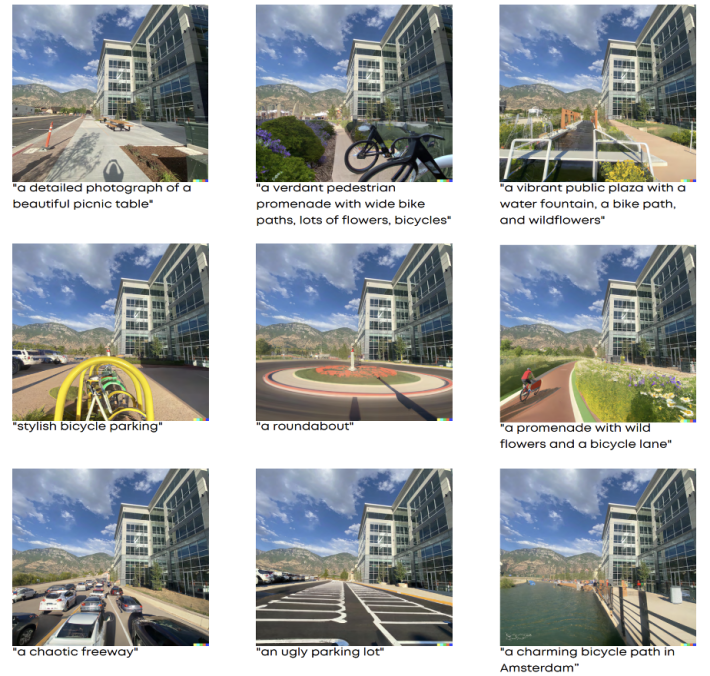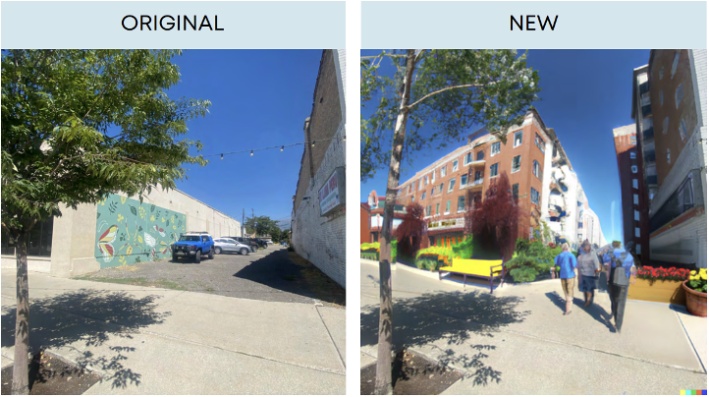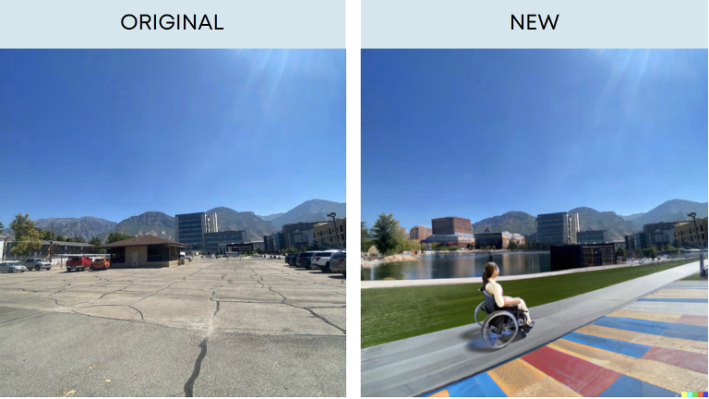If you’ve ever wished you could show stakeholders the benefits of smart street design (rather than simply talking about it), you may be in luck. New AI image generators have become surprisingly powerful and are offering the public tools that used to be available only to established artists and researchers.
As a citizen advocate, I’ve been playing with OpenAI’s DALL-E 2 in order to re-imagine streets in my mid-sized city. Just for fun, I put together a booklet of the most effective AI prompts for generating street renderings.
The good news is that DALL-E 2 just opened a public beta release, allowing a million users to access its generator for free.
That could be a game-changer for safe street advocates eager to use such images.
Streetsblog reported on the ways AI artists such as Zach Katz have been using DALL-E 2 in order to generate compelling renderings of redesigned streets. Through his @betterstreetsai Twitter account, Katz has shared his AI generated renderings of some popular (and concerning) streets, such as this attention-raising redesign of Storrow Drive in Boston:
Storrow Drive (Boston, Massachusetts) pic.twitter.com/NPbwZXHpUF
— AI-generated street transformations (@betterstreetsai) August 16, 2022
Katz’s renderings were so effective at initiating social media discussions that he recently started an advocacy site, transformyour.city, that helps citizens share these images with their elected representatives in order to advocate for change.
But, like Katz, most AI artists have started with the big targets (such as well-known streets in major cities), leaving smaller streets and mid-sized cities to their own devices. Now everyone can use such tools.
DALL-E 2 users start off with 50 free image generation credits and can refill their accounts with 15 credits a month. (You can also purchase more credits if you can’t stop yourself from tinkering with your city snapshots.) Because the tool generates art based on word prompts, you don’t need to have artistic skills — just a good eye and a street-oriented vocabulary.
An effective DALL-E 2 prompt is generally made up of a combination of street descriptions (bike lanes, roundabouts, pedestrian promenades) and vibes (charming, dystopian, historic, chaotic).
Once you have access to the DALL-E 2 site, you can use the tool to re-imagine streets by uploading a photo, using the eraser tool to blot the part of the street that you’d like to re-design, and entering a short prompt describing what you’d like to see instead.
DALL-E 2 images can feel a bit uncanny. The generator often renders strange details on pedestrian faces and bicycles. It's no match for professional design work. But the tool could be a game changer for advocacy groups that don’t have the budget or the time for professional street renderings.
The best way safe street advocates can use DALL-E 2 is as a tool for speculative design, in order to generate conversation about potential projects. Here are three practical applications:
1. What would the street look like if it had protected bike lanes? Light rail? Green space? A pedestrian plaza? AI can help you think big and share big visions with stakeholders.
2. DALL-E 2 can bring bad street design to life before projects receive approval. Advocates might use the images at public meetings in order to show how a neighborhood might be affected by the expansion of a highway or a parking lot.
3. Use the generator to demonstrate alternatives to bad proposals, showing what a better choice could look like in a series of renderings.
The tools offer a quick-and-dirty way to help low-budget organizations share a different vision of our streets. To be honest, it’s also a fun way to spend a couple hours daydreaming.
Jamie Littlefield (@writingjamie) is an advocate for safer streets and the vice chair of BikeWalk Provo. She researches the rhetoric of city planning and the ways language influences the built environment and recently released the free PDF booklet "Re-Imagining Public Space with DALL-E 2 AI: A Prompt Book for City Planners, Designers, Developers, and Citizen Activists."











